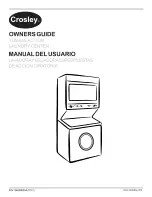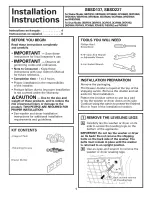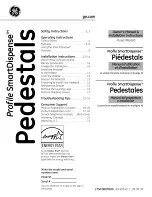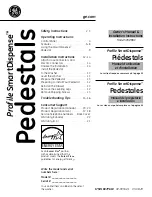
16
Pellerin Milnor Corporation
Table 6.
Mechanisms and Settings
Mark
Do this each
Component
More Data
1 2 3 4 5 6
x 2400 hours
controller circuitry
Examine wiring and connections in electrical boxes.
Look for corrosion, loose connections. See
x
200 hours
water pressure regulator
for optional supply
injector
See
,
. Value: 28 PSI (193 kPa).
x
200 hours
water pressure regulator
for chemical flush
See
. Value: 28 PSI (193 kPa).
x
200 hours
bath level sensor that uses
air pressure
Examine the air tube and connections. See
3.1.2
How To Remove Contamination
BNUUUH01.R03 0000335794 A.7 A.26 A.2 2/18/21 10:13 AM Released
Table 7.
Contamination Types, Cleaning Agents, and Procedures
Material or
Component
Usual
Contamination
Example
Cleaning Agent
More Data
machine housing
dust, dirt
—
compressed air or
shop vacuum
Air—no more than 30 psi (207 kpa).
Do not push dust in mechanisms.
fins and vents on
electrical
components
dust
motors, inverters,
braking resistors
shop vacuum, soft
bristle brush, canned
air for electrical
components
Do not push dust in mechanisms.
electric box
interior
dust
all electric boxes
electrical
connections
corrosion, varnish spade connector,
molex connector,
plug-in relay
spray solvent for elec-
trical components
Disconnect then connect it again.
Use solvent if the bad connection
continues.
electronic sensors dust
photoeye lens, re-
flector, laser, prox-
imity switch,
temperature probe
none
Use a clean, soft, dry cloth.
dirt
warm water with soap,
then water flush
Use clean, soft cloths.
stainless steel
chemical spill
shell, supply
injector
water
Use a hose to flush the chemical
supply from the surface fully. Do
not get water on electrical compo-
nents or mechanisms.
300 series stain-
less steel
chemical corro-
sive attack
shell interior,
cylinder
pickling and
passivation
Speak to your dealer or Milnor. This
is not routine maintenance.
painted metal,
unpainted
aluminum
dust, dirt, grease
frame members
warm water with soap,
then water to flush
Use clean cloths. Do not get water
in electrical components.
rubber
dirt, oil, grease
drive belts, hoses
warm water with soap,
then water to flush
Use clean cloths. Flush fully. Oil or
soap must not stay on drive belts.
Make sure that drive belts are
serviceable.
clear plastic,
acrylic
discoloration
(yellowing)
compressed air fil-
ter bowl, visual
flow meter
warm water with soap,
then water to flush,
then acrylic cleaner.
Do not use ammonia.
Use only the necessary cleaning
agents. Wash and rinse with clean,
soft cloths. Follow instructions on
acrylic cleaner.
Summary of Contents for 30015T6X
Page 2: ......
Page 4: ......
Page 5: ...English 1 ...
Page 6: ......
Page 10: ...Pellerin Milnor Corporation iii Table 10 Where to Put Marks On a Calendar 21 Contents ...














































